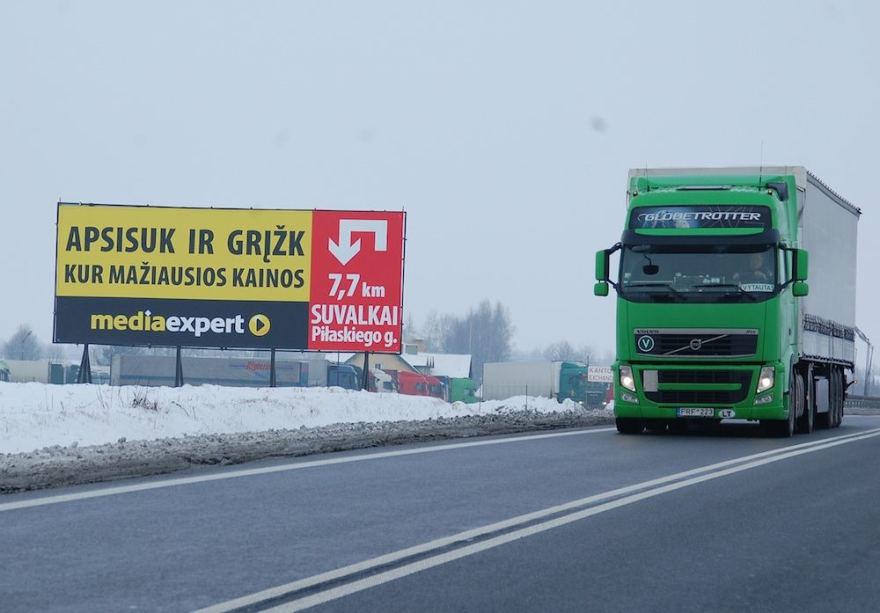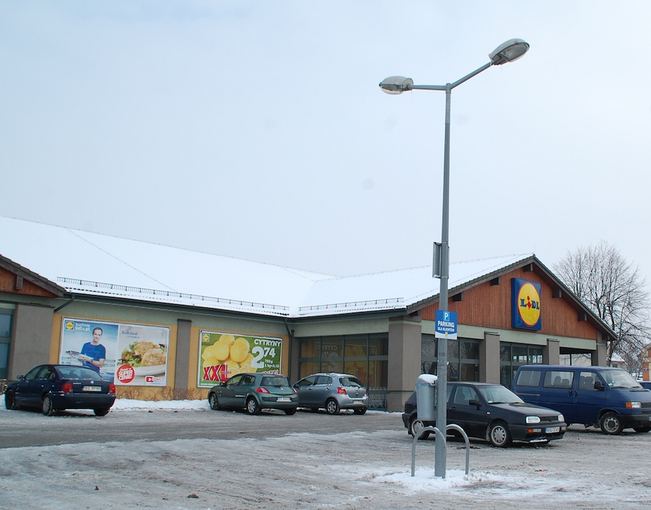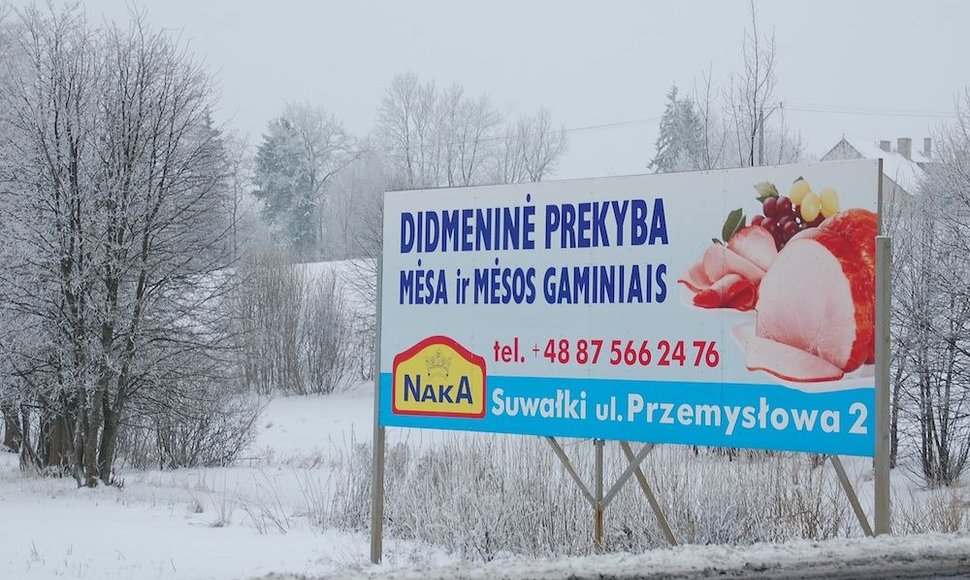One hardly notices as one enters Poland on the road from Kaunas to Suwalki. Differently-coloured road signs are perhaps the only indication one has crossed the border, otherwise everything looks like at home.
Billboards that punctuate the landscape invite shoppers to a store for kids, inform about the best place to buy fresh meat, dairy products, advertise a supermarket for bathroom tiles. There are ads for farming machinery, sports gear, plumbing necessities, windows, roofs, even candles and fireworks.
An ad of one shopping centre is rather ingenuous – a billboard, facing drivers on their way back to Lithuania, reads, in Lithuanian: “Turn around and go back to the place of lowest prices.”
 |
| Eglės Digrytės nuotr./Reklama |
Little choice
Every other car I pass on the way to Suwalki bears Lithuanian licence plates. However, it is hardly an uninterrupted flow of shoppers one might expect after hearing so much about how cheap everything is in Poland. Perhaps because it is already well past noon – and a workday?
I approach the first big supermarket in Suwalki, Kaufland. I do not stop – on-line forums advise against settling for the first spot which is likely to be relatively pricey – and drive instead further into town. Across the road, there is a smaller shop, Biedronka (Ladybird). Veteran shoppers recommend going to Lidl for the lowest prices.
And it is cheap indeed – the setting reminds of a wholesale outlet, with products stacked on the floor in big carton boxes, except the range of choice is rather small. Only two kinds of apples. Not much to choose from for pasta or cereals. There is a meat galore, but yoghurt and other dairies are scarce.
 |
| Eglės Digrytės nuotr./Prekybos centras „Lidl“ |
Buying fish in Lithuania
Everyone in the row between two shelves is Lithuanian – even some tags in the store are printed in Lithuanian.
I talk to Julius, who is picking beer with his father. They are comparing prices, considering whether to opt for a bigger package, and trying to remember which brand tastes better. “This will be for dessert,” the young man laughs. “We did not come to Suwalki for beer – we need all kinds of food: meat, oil, canned products, vegetables, yoghurt.” Julius's shopping cart is half empty – the family lives by the border and can afford to come to Suwalki often.
In the parking lot, one man is holding ten packs of long-life milk and struggling with his car keys. The car bears Lithuanian licence plates, so I greet him and ask how often he comes to Suwalki – noting how little he has bought. He smiles and tells me to wait.
Leaving me to look after his unlocked car, he runs back into the supermarket and soon emerges with bags in his hands and a woman pushing a full shopping cart.
Nijolė and Andrejus Igumnovai live in the village of Lepuškiai, some 12 kilometres from Druskininkai, and come to Suwalki after each payday to get food for the entire coming month. They hardly need to go grocery shopping after that – long-life milk stays good and the family bakes its own bread. Nijolė admits she only buys carps in Lithuania.
Spending 400 litas at a time
The couple “discovered” Suwalki in the wake of the economic downturn. They visit several outlets and already know the spots with cheaper or better foods. For instance, they go to Kaufland for eggs and meat for their dog. They bypass the open-air market because it is tricky to access it by car – they only drop by in summer to buy fresh strawberries.
Regular shoppers note that prices have gone up lately, while exchange rate of the zloty is less favourable, too. One Polish zloty used to fetch 0.74 Lithuanian litas in 2009, whereas now it is worth 0.84-0.85 litas.
Nijolė says she exchanges 400 litas (116 euros) for each trip. The difference between what the family pay in Poland and what they would pay in Lithuania suffices to cover gas. They used to spend twice as much before – back then, the difference was enough for the trip to Suwalki and two weeks of commuting to Druskininkai, where her husband works.
Neighbours of the Igumnovai family do not usually ask them to get them something from Poland – most go there themselves and even exchange tips on where to find best deals.
Lithuanian shoppers are easily recognizable
I make a stop at Tesco which opened a year ago. Clothes, cleaners, cosmetics, haberdashery, kitchenware predominate here, while foodstuffs make up but a small fraction of what's on offer. It is relatively expensive, too. At noon on a working day, it is empty of Lithuanians and shoppers in general.
On my way back, I park outside Kaufland. There are many cars here, every third from Lithuania.
All it takes to tell Lithuanian shoppers apart is to take a look at their carts. Poles are shopping for bread, oranges, shampoo, cheese; Lithuanians, for canned food, fresh meat and meat products, yoghurt, dairies, eggs, bananas, toilet paper, nappies. They take everything in bigger quantities.
Pre-holiday visit
Even though the supermarket has started advertising in the Lithuanian press, it is unlikely that most shoppers were drawn here by newspaper ads. Kaufland is situated in a perfect spot – on the main road from Marijampolė tu Suwalki. Prices are not much higher than in Lidl ans some things are even cheaper – not to mention a much broader range of choice.
That is why Ričardas from Marijampolė does not waste time on “tours” around other supermarkets. He says he comes here for an hour with a shopping list made by his wife – just in and out and back home.
He buys some oil this time, a big box of eggs, a bag of apples, several packs of milk and juice, some flour, rice, pork, smoked fish, curd, yoghurt and chocolate for kids, cat food. He also plans to fill up in a nearby gasoline station – fuel costs 20 cents less here than in Marijampolė.
The young man only comes to Suwalki occasionally, usually before Christmas, Easter, birthdays, and other holidays. His fellows, who come to Poland more often, has advised him that shopping in Suwalki is worthwhile if one spends at least 700 to 1,000 litas (200-300 euros), especially if one lives further from the border.
 |
| Eglės Digrytės nuotr./Prekybos centras „Kaufland“ |
More expensive cleansers and cosmetics
Ričardas says he does not ponder on what things are better to buy in Suwalki and what at home. “One can see at a glance that prices differ. Figures are usually the same as in Lithuania or lower – not to mention special offers,” he explains. And since zloty is cheaper than litas, purchases are effectively cheaper by a dozen percent.
Polish retailers win on lower taxes. The value-added tax on essential foods in Poland stands at 5 percent, on other groceries, 8 percent. In Lithuania, the value-added tax on all foods is 21 percent.
After inspecting the shelves, I am convinced that Ričardas is right. Most products cost less than in Lithuania – and there are special offers, too.
Not all things, however, seem enticing. Cleansers, shampoos, certain products for pets cost more than in Lithuania.
Millions lost
According to a survey commissioned by the Association of Lithuanian Trade Enterprises last spring, Polish shopping trips deprive Lithuanian business of 32.6-49 million litas per month. Or 391-588 million annually.
According to the survey, 12 percent of the Lithuanian population regularly go to Poland to shop. A typical shopper is most likely to be from Kaunas, Klaipėda, Marijampolė, or Tauragė County, aged between 35 and 44. Previously, Polish supermarkets were more popular with older people from Marijampolė County.
On average, Lithuanians spend 442 litas (128 euros) per trip. That means that a sum of 1.5 million litas is taken out of the country daily.
 |
| Eglės Digrytės nuotr./Reklama |













